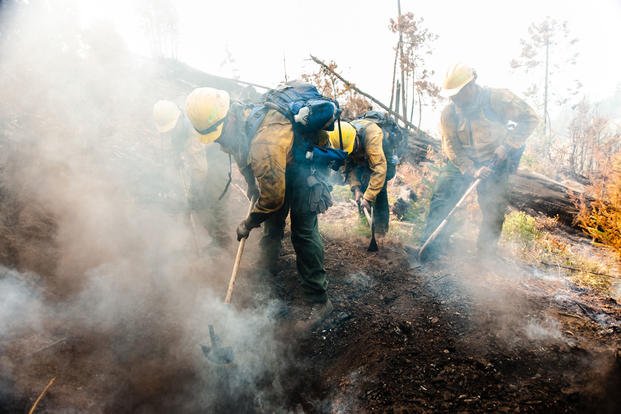Could artificial intelligence systems predict the next major natural disaster? It's one of the ways the Defense Department wants to leverage the technology in partnership with tech companies, according to a new report.
Officials on Tuesday unveiled the Trump administration's new effort to streamline the use and development of AI for homeland security, as well as military operations abroad. But the report, titled, "Department Of Defense Artificial Intelligence Strategy: Harnessing AI To Advance Our Security And Prosperity," also pinpointed applications in which smart algorithms could address "global challenges of significant societal importance, such as operationalizing AI for humanitarian assistance and disaster relief for wildfires, hurricanes and earthquakes."
"We will bring our data, domain expertise, and real-world problems to these public-private partnerships, and combine efforts with a wide range of actors to produce inspiring AI technology that benefits society beyond the benefit of fulfilling our core defense mission," the report said.
During a roundtable discussion Tuesday at the Pentagon, Lt. Gen. John "Jack" Shanahan, director of the department's new Joint Artificial Intelligence Center, told reporters military officials will work with tech companies to launch pilot projects that could improve natural disaster response by leveraging AI.
One of those projects will specifically look at tackling wildfires in the western United States, Shanahan said, as reported by the Wall Street Journal. Shanahan, previously the director for defense intelligence for warfighter support and leader of the Pentagon-Google Project Maven partnership, spoke on the content of the new report.
"Commercial solutions are available for most of the problems we've had in the past and most of the solutions we'll find in the future," Shanahan said, adding that algorithms could sift through drone data and imagery and predict the path a fire could take. Firefighters or aircraft could then be dispatched to the predicted locations to stop the fire’s progress.
The general said it's more likely companies would be willing to work with the Pentagon for humanitarian assistance relief such as fighting wildfires, the Wall Street Journal said.
For example, Google announced last year it would not pursue another contract with Project Maven after its current contract expires this year. Company employees reportedly voiced concerns about their artificial intelligence resources being used by the U.S. military for deadly warfare.
The new AI report follows a recent 22-page DoD climate study, which highlighted how bases around the country are faced with "significant vulnerabilities" due to climate change, and how the military itself must contend with new challenges due to "climate-related events."
The climate study said more than two-thirds of operational U.S. military installations are threatened by drought, recurrent coastal flooding, wildfires, extreme heat and extreme cold.
In October, Chairman of the Joint Chiefs of Staff Gen. Joseph Dunford told audiences at the annual Military Reporters and Editors Conference that top brass has to "think about weather as an adversary."
A few weeks later, Dunford expanded on the idea, saying climate is a source of conflict, migration and other human activities, but also something that takes troops away from home during response missions.
"When I look at climate change, it's in the category of sources of conflict around the world and things we have to respond to," he said at a Duke University event. "It can be great devastation requiring humanitarian assistance, disaster relief, which the U.S. military certainly conducts routinely."
He continued, "In fact, I can't think of a year since I've been on active duty that we haven't conducted at least one operation in the Pacific along those lines due to extreme weather in the Pacific. And then, when you look at source of conflict -- shortages of water, and those kind of things -- those are all sources of conflict.
"So it is very much something that we take into account in our planning as we anticipate when, where and how we may be engaged in the future and what capabilities we should have," the chairman said.
-- Oriana Pawlyk can be reached at oriana.pawlyk@military.com. Follow her on Twitter at @oriana0214.










